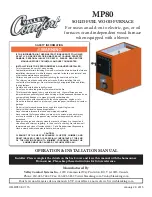
508148-01
Issue 2128
Page 54 of 75
When checking piping connections for gas leaks, use
preferred means. Kitchen detergents can cause harmful
corrosion on various metals used in gas piping. Use of a
specialty Gas Leak Detector is strongly recommended.
Do not use matches, candles, flame or any other
source of ignition to check for gas leaks.
Testing Gas Supply Pressure
An inlet post located on the gas valve provides access to
the supply pressure. See Figure 51. Back out the 3/32 hex
screw one turn, connect a piece of 5/16 tubing and connect
to a manometer to measure supply pressure. See Table 24
for supply line pressure.
Check Manifold Pressure
A manifold pressure post located on the gas valve provides
access to the manifold pressure. See Figure 51. Back
out the 3/32 hex screw one turn, connect a piece of 5/16
tubing and connect to a manometer to measure manifold
pressure.
To correctly measure manifold pressure, the differential
pressure between the positive gas manifold and the
negative burner box must be considered.
For safety, shut unit off and remove manometer as soon
as an accurate reading has been obtained. Take care to
replace pressure tap plug.
IMPORTANT
The gas valve is factory set and should not require
adjustment. All gas valves are factory regulated.
1.
Connect the test gauge positive side “+“ to manifold
pressure tap on gas valve as noted above.
2. Tee into the gas valve regulator vent hose and connect
to test gauge negative “-”.
3.
Ignite unit on low fire and let run for 5 minutes to allow
for steady state conditions.
4.
After allowing unit to stabilize for 5 minutes, record
manifold pressure and compare to value given in
5.
If necessary, make adjustments. Figure 51 shows
location of high fire and low fire adjustment screws.
6. Repeat steps 3, 4 and 5 on high fire. See values in
7.
Shut unit off and remove manometer as soon as an
accurate reading has been obtained.
8.
Start unit and perform leak check. Seal leaks if found.
Proper Gas Flow (Approximate)
Furnace should operate at least 5 minutes before checking
gas flow. Determine time in seconds for two revolutions of
gas through the meter. (Two revolutions assures a more
accurate time.) Divide by two and compare to time in Table
22. If manifold pressure matches Table 24 and rate is
incorrect, check gas orifices for proper size and restriction.
NOTE:
To obtain accurate reading, shut off all other gas
appliances connected to meter.
Model
Seconds for One Revolution
Natural
LP
1 cu ft
Dial
2 cu ft
Dial
1 cu ft
Dial
2 cu ft
Dial
-045
80
160
200
400
-070
55
110
136
272
-090
41
82
102
204
-110
33
66
82
164
-135
27
54
68
136
Natural - 1000 btu/cu ft
LP - 2500 btu/cu ft
Table 22. Gas Meter Clocking Chart
For safety, shut unit off and remove manometer as soon
as an accurate reading has been obtained. Take care to
replace pressure tap plug.
IMPORTANT
Proper Combustion
Furnace should operate minimum 15 minutes with correct
manifold pressure and gas flow rate before checking
combustion. Take combustion sample beyond the flue
outlet and compare to Table 23.
The maximum carbon
monoxide reading should not exceed 100 ppm.
Model
CO
2
% for Nat
CO
2
% for LP
Low Fire
High Fire
Low Fire
High Fire
-045
5.4 - 6.4
7.5 - 8.5
6.4 - 7.4
8.8 - 9.8
-070
5.3 - 6.3
7.4 - 8.4
6.3 - 7.3
8.7 - 9.7
-090
5.8 - 6.8
7.6 - 8.6
6.8 - 7.8
8.9 - 9.9
-110
6.1 - 7.1
8.0 - 9.0
7.1 - 8.1
9.3 - 10.3
-135
6.1 - 7.1
7.8 - 8.8
7.1 - 8.2
9.1 - 10.1
The maximum carbon monoxide reading should not exceed
100ppm.
Table 23.
















































